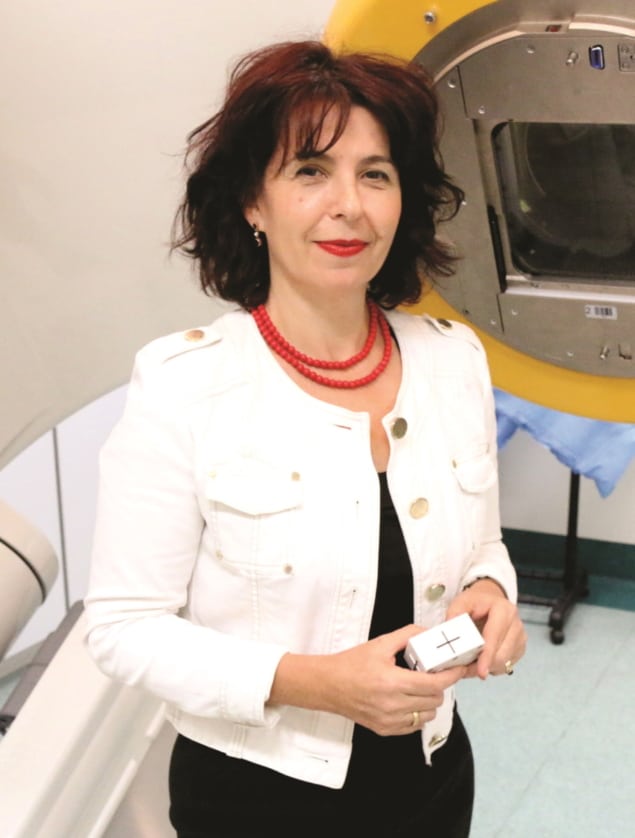Radiotherapy innovation: optimize the physics, but don’t ignore the biology
08 Sep 2021 Tami Freeman
Exceptional contribution: Natalka Suchowerska received the ESTRO honorary membership award for her achievements in innovation. (Courtesy: N Suchowerska)
“I’d like to reflect on the relationship between the successes we’ve had with physics and technology – and the relative neglect of the biology – in radiation therapy.” With these bold words, Natalka Suchowerska opened her presentation at the recent ESTRO 2021 meeting.
Suchowerska, co-director of VectorLAB and associate professor at the University of Sydney, described how the development of new radiotherapy technologies has enabled the introduction of advanced treatment techniques into routine clinical practice. It’s now possible to reduce target margins to zero and escalate prescriptions to more lethal doses. But, she asked, will doubling the accuracy of radiotherapy yield the result we really strive for: a measurable clinical improvement? Moving forward, where are our efforts best directed?
“The real question is whether we can predict patient outcome with the same accuracy as we predict dose,” she explained. “I’ve no doubt that we have the technical ability, but do we have the required understanding of the body’s response to the radiation to move this frontier further?”
One obstacle is that many of the emerging treatment techniques, such as microbeams and FLASH radiotherapy, introduce unprecedented spatial or temporal modulation of the radiation beam. Such approaches have the potential to significantly improve clinical outcomes, but this non-uniform irradiation creates a biological complexity that traditional radiobiology models were not designed to predict. “Even today, we don’t fully understand the biological mechanisms after exposure to highly spatially and temporally modulated beams,” said Suchowerska.
While techniques such as dosimetry, quality management, treatment planning and tumour tracking are tangible technologies that emerge from the clinic and are promoted by vendors, radiobiology is the understanding of the body’s natural response to radiation.
“The commercial sector has no interest in promoting understanding, so whose responsibility is it to lead?” asked Suchowerska. The technical developments needed to create and deliver microbeams and FLASH treatments will keep the physicists busy and the commercial sector happy, she explained. But the true power of this technology lies in understanding the body’s response and how we can harness and drive that response to the best outcome for patients.
More than just the dose
Suchowerska described a study performed by her team, in which prostate cells were irradiated with uniform and spatially modulated clinical radiation beams. The researchers then used mass spectrometry and NMR techniques to examine the metabolites expressed by the irradiated cells. In a normal prostate cell line, they found the expression after uniform or modulated 3 Gy irradiation to overlap. In prostate cancer cells, however, a 1.5 Gy modulated field resulted in a similar metabolite expression as a 2.25 Gy dose from a uniform field.
“So we started to see that the dose is not necessarily a good surrogate for biological response,” Suchowerska explained.
As new technologies emerge, there’s an urgent need to understand the biological effects that they create, in order to make the biology work with us and exploit the opportunities promised by these fledgling techniques. “To improve radiotherapy practice, the next step is to advance our understanding of the biological mechanisms to the same level as we understand the operation of our dosimeters,” said Suchowerska.
To achieve this, medical physicists may have to reach beyond their comfort zones. They will need to work in interdisciplinary teams and collaborate with experts in other fields. “We must value the expertise we have,” Suchowerska told the ESTRO audience. “However, to realise our ultimate goal, our work can’t just end at dose and dose distribution and the optimal operation of the technology. To advance the next frontier, we need to work with other disciplines that bring their expertise to the table. By understanding the biological mechanisms, we have the roadmap of how we need the technology to operate.”Natalka Suchowerska presented this talk in recognition of being awarded honorary membership of ESTRO for her achievements in innovation. This award is presented as an acknowledgement of the recipient’s exceptional contribution to radiotherapy and oncology, particularly in the field of interdisciplinary or international co-operation.

Tami Freeman is an online editor for Physics World
from physicsworld.com 12/12/2022

Δεν υπάρχουν σχόλια:
Δημοσίευση σχολίου